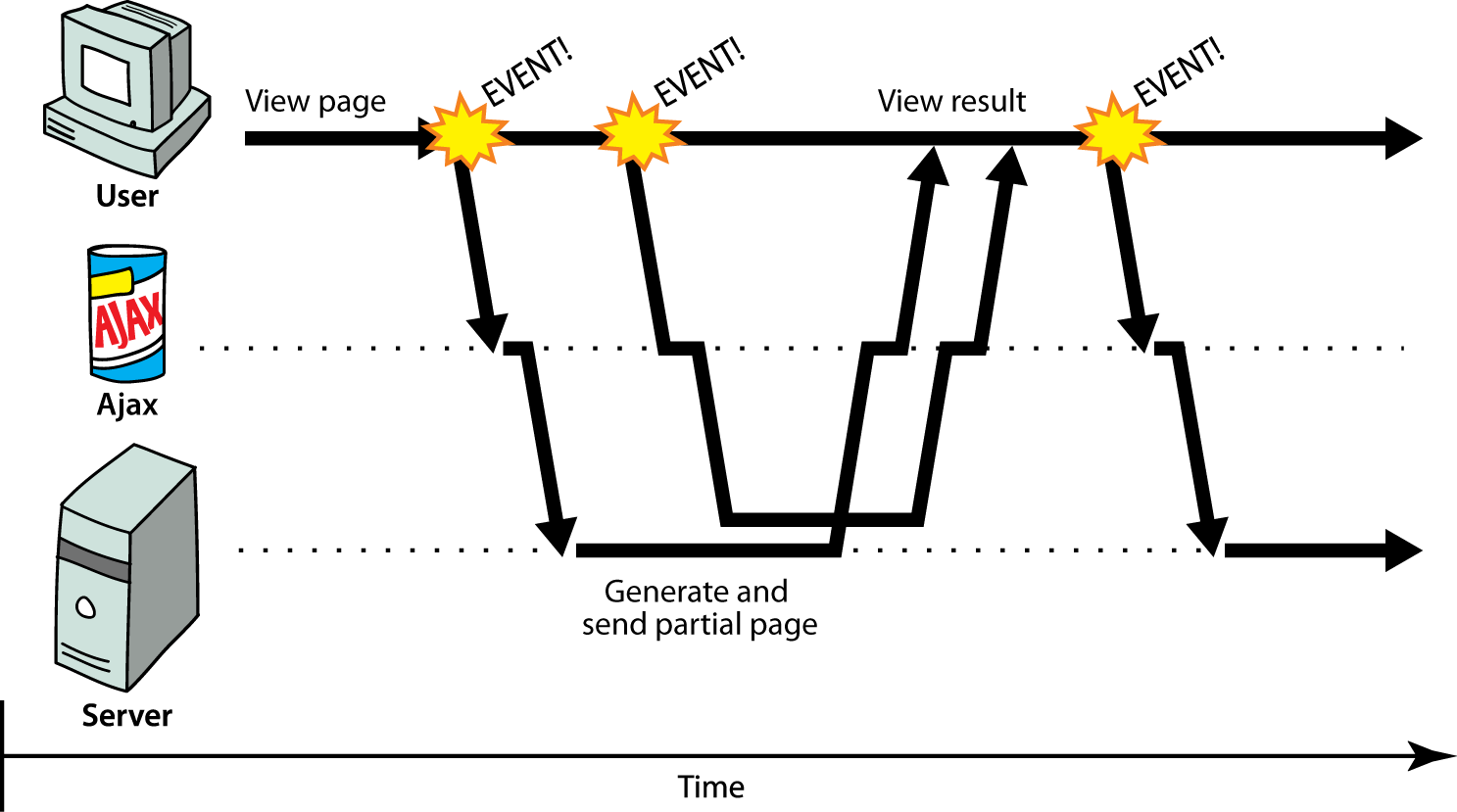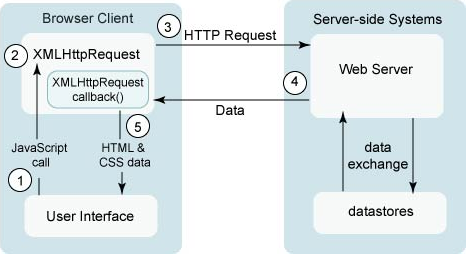CSSE 290 Web Programming
Lecture 22: Ajax examples
Reading: 12.2
Except where otherwise noted, the contents of this document are Copyright 2012 Marty Stepp, Jessica Miller, and Victoria Kirst. All rights reserved. Any redistribution, reproduction, transmission, or storage of part or all of the contents in any form is prohibited without the author's expressed written permission.
Otherwise note: Claude Anderson was given permission to modify the slides for CSSE 290 at Rose-Hulman by author Jessica Miller. The authors' original slides, based on Web Programming Step by Step, can be seen at http://webstepbook.com.
Some of the examples in some days' slides are from David Fisher at Rose-Hulman, who was kind enough to allow me to use them. My intention is to mark these examples with [DSF].
Recap: Asynchronous web communication

- asynchronous: user keeps interacting with page while new data loads
- communication pattern made possible by Ajax
Recap: A typical Ajax request

- user clicks, invoking an event handler
- handler's code creates an
XMLHttpRequestobject XMLHttpRequestobject requests info from server- server retrieves appropriate data, sends it back
XMLHttpRequestfires an event when data arrives- we attach a handler function to this event (callback)
- callback event handler processes the data and displays it
Recap: Prototype's Ajax model
new Ajax.Request("url", {
option : value,
option : value,
...
option : value
});
- construct a Prototype
Ajax.Requestobject to request a page from a server using Ajax - constructor accepts 2 parameters:
- the URL to fetch, as a String,
-
a set of options, as a set of key : value pairs in
{}braces (an anonymous JavaScript object)
- hides messy details of the raw
XMLHttpRequest; works well in all browsers
Recap: Prototype Ajax options
| option | description |
|---|---|
method
|
how to fetch the request from the server (default "post")
|
asynchronous
|
should request be sent asynchronously in the background? (default true, for good reasons)
|
parameters
|
query parameters to pass to the server, if any (as a string or object) |
onSuccess
|
event: request completed successfully |
onFailure
|
event: request was unsuccessful |
onException
|
event: request has a syntax error, security error, etc. |
others: contentType, encoding,
requestHeaders; events: onCreate, onComplete,
on### (for HTTP error code ###, example on404)
|
|
Prototype Ajax example
new Ajax.Request("foo/bar/mydata.txt", {
method: "get",
onSuccess: myAjaxSuccessFunction
});
...
function myAjaxSuccessFunction(ajax) {
do something with ajax.responseText;
}
- attach an event handler function to the request's
onSuccessevent - the handler takes an Ajax response object as a parameter, which we'll name
ajax
Ajax response object's properties
| property | description |
|---|---|
status
|
the request's HTTP result code (200 = OK, etc.) |
statusText
|
HTTP status code text |
responseText
|
the entire text of the fetched file, as a string |
responseXML, responseJSON
|
the entire contents of the fetched file, in other formats (seen later) |
function myAjaxSuccessFunction(ajax) {
alert(ajax.responseText);
}
- most commonly used property is
responseText, to access the fetched text content
Handling Ajax errors
new Ajax.Request("url", {
method: "get",
onSuccess: functionName,
onFailure: ajaxFailure,
onException: ajaxFailure
});
...
function ajaxFailure(ajax, exception) {
alert("Error making Ajax request:" +
"\n\nServer status:\n" + ajax.status +
" " + ajax.statusText +
"\n\nServer response text:\n" + ajax.responseText);
if (exception) {
throw exception;
}
}
- for user's (and developer's) benefit, show an error message if a request fails
Debugging Ajax code

- Firebug Net tab (or Chrome's Network tab) shows each request, parameters, response, errors
- expand a request with + and look at Response tab to see Ajax result
- check Console tab for any errors that are thrown by requests
Passing query parameters to a request
new Ajax.Request("lookup_account.php", {
method: "get",
parameters: {name: "Ed Smith", age: 29, password: "abcdef"},
onFailure: ajaxFailure,
onException: ajaxFailure
});
...
- don't concatenate the parameters onto the URL yourself with
"?" +...- won't properly URL-encode the parameters
- won't work for POST requests
- query parameters are passed as a
parametersobject,{}braces with name : value pairs- (the above is equivalent to:
"name=Ed+Smith&age=29&password=abcdef")
- (the above is equivalent to:
Creating a POST request
new Ajax.Request("url", {
method: "post",
parameters: {name: value, name: value, ..., name: value},
onSuccess: functionName,
onFailure: functionName,
onException: functionName
});
methodshould be changed to"post"(or omitted;postis default)
XMLHttpRequest security restrictions

- Ajax must be run on a web page stored on a web server
- Ajax can only fetch files from the same server that the page is on
http://www.foo.com/a/b/c.htmlcan only fetch fromwww.foo.com
Prototype's Ajax Updater
new Ajax.Updater("id", "url", {
method: "get"
});
Ajax.Updaterfetches a file and injects its content into an element asinnerHTML- this is a common Ajax use case: "go fetch this page/file, and put its contents into an element on the page"
- could do this with
Ajax.Request, butAjax.Updatersaves you some typing and work
- additional (1st) parameter specifies the
idof element to inject into onSuccesshandler not needed (butonFailure,onExceptionhandlers may still be useful)
Ajax.Updater options
new Ajax.Updater({success: "id", failure: "id"}, "url", {
method: "get",
insertion: "top"
});
- instead of passing a single id, you can pass an object with a
successand/orfailureid- the
successelement will be filled if the request succeeds - the
failureelement (if provided) will be filled if the request fails
- the
insertionparameter specifies where in the element to insert the text (top, bottom, before, after)
PeriodicalUpdater
new Ajax.PeriodicalUpdater("id", "url", {
frequency: seconds,
name: value, ...
});
Ajax.PeriodicalUpdaterrepeatedly fetches a file at a given interval and injects its content into an element asinnerHTMLonSuccesshandler not needed (butonFailure,onExceptionhandlers may still be useful)- same options as in
Ajax.Updatercan be passed
Ajax.Responders
Ajax.Responders.register({
onEvent: functionName,
onEvent: functionName,
...
});
- sets up a default handler for a given kind of event for all Ajax requests
- can be useful for attaching a common failure/exception handler to all requests in one place

